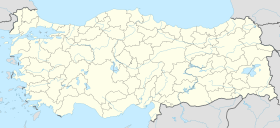Rhoiteion
Ῥοίτειον | |
| Location | İntepe, Çanakkale Province, Turkey |
|---|---|
| Region | Troad |
| Coordinates | 40°0′33″N 26°18′0″E / 40.00917°N 26.30000°E |
| Type | Settlement |
| History | |
| Founded | Late 8th century BC at the latest |
Rhoiteion (
Foundation
According to the Greek geographer
History
The earliest source to mention Rhoiteion is the 5th century BC historian
Rhoiteion's greatest asset was the suitability of its coast for harbouring ships and its location on the
Outside myth (see below on The Tomb of Ajax), Rhoeteion is rarely mentioned after the
The Tomb of Ajax
Rhoiteion was best known in Antiquity for the Tomb of
The geographer Strabo, writing in the latter half of Augustus' reign, relates that the Emperor Augustus returned to the Rhoiteians a statue of Ajax which had adorned the top of his burial tumulus until Mark Anthony had stolen it to give to his lover Cleopatra. Strabo then explains, "For Anthony took away the finest dedications from the most famous temples to gratify the Egyptian woman (i.e. Cleopatra), but Augustus gave them back to the gods".[26] Following the reign of Augustus, this became the dominant version of the myth for the rest of Antiquity.[27] In Pliny the Elder (mid-1st century AD) we hear of the promontory near İn Tepe referred to as Aeantion meaning 'the place of Ajax' (from Ancient Greek Αἰάντειον).[28] Prior to this, the only mention of this promontory was in an Athenian inscription from 375 BC referring to a military action by the general Chabrias and honouring "the soldiers who were allies at Aianteion on the Hellespont".[29] In the 2nd century AD further details appear: the Greek travel writer Pausanias claimed that a local Mysian had informed him that the sea washed away the entrance to Ajax's tomb, and when locals looked inside, they discovered the bones of a giant man 11 cubits (or 5 metres) tall.[30] This story recalls a common view in Graeco-Roman Antiquity that heroes of a previous age were much larger than present-day men; a famous example is the story of the discovery of the bones of Orestes, the son of Agamemnon, which the 5th century BC historian Herodotus relates.[31] It was also in this period (probably during the reign of the philhellenic emperor Hadrian) that the tumulus of Ajax was renovated and given its present vaulting, suggesting local investment in what had become Rhoiteion's great attraction.[32]
References
- ^ Dictionary of Greek and Roman Geography (1854), Rhoeteum
- ^ Cook (1973) 77–90 with Fig. 3.
- ^ Strabo 13.1.42.
- ^ Scholia on Apollonius of Rhodes, Argonautica 1.929 (ed. Wendel), cf. Scholia on Lycophron 583, 1161; Bürchner, RE IA col. 1006.
- ^ Cook (1973) 80–1.
- ^ Herodotus, 7.43.2.
- ^ Hellanicus, FGrHist 4 F 25b = Strabo 13.1.42.
- ^ IG I3 71.III.126 (restored), IG I3 77.IV.16. See Carusi (2003) 32–3.
- ^ Thucydides 4.52.2, Kallet-Marx (1993) 155–9.
- ^ Tryphiodorus, Iliou Persis 216, Libanius, Orationes 1.15, Scholia on Homer, Iliad 7.339b1, 14.36, 23.365, Scholia on Lycophron 276, 581.
- ^ Thucydides 8.101.3, Xenophon, Hellenica 1.1.2.
- ^ Cook (1973) 86–7.
- ^ Philostratus, Life of Apollonius of Tyana 4.13, Zosimus 2.23–4.
- ^ Cook (1973) 83.
- ^ Diodorus Siculus 17.7.10.
- ^ IG XI (4) 582. Further citizens of Rhoiteion have been identified by Louis Robert: L. Robert, Etudes de Numismatique Grecque (1951) 10 n. 5, L. Robert, Monnaies antiques en Troade (1966) 19 n. 1.
- ^ Appian, Syriaca 23.
- ^ Strabo 13.1.39.
- ^ Cook (1973) 83–6. This may explain a curious passage in Aelian, De Natura Animalium 25.16, in which the population of Rhoiteion is driven out by a plague of millipedes: Cook (1973) 86, Carusi (2003) 32.
- ^ Cook (1973) 82 n. 6, 88–9.
- Hellenistic poet Apollonius of Rhodes(early 3rd century BC) without any mention being made of a connection with Ajax.
- Hellenistic poet Callimachus.
- ^ Catullus Carm. 65.8.
- ^ Virgil, Aeneid 6.505; Bleisch (1999) 194–6. The poem Culex in the Appendix Vergiliana, which at lines 311ff contains an allusion to Telamonian Ajax being buried at Rhoiteion and which, like the rest of this collection, purports to be genuine juvenalia by Virgil, has long been recognized as spurious and is likely to date to the reign of Tiberius.
- ^ Ovid, Metamorphoses 11.196–8, cf. Ovid, Ibis 283.
- ^ Strabo 13.1.30.
- AjaxHypothesis scholion 4.
- Naturalis Historia5.125. From the 2nd century AD onwards, Αἰάντειον was also spelt Αἰάντιον.
- ^ SEG 19.204 fr. b.2–3: [οἱ στρατι]ῶται οἱ ἐν τ[ῶι Αἰ]αντε[ί]ω̣ι τῶι [ἐν Ἑλλησπό]ντωι σ[υμμαχ]εσά[με]νοι, 'the soldiers who were (our) allies at Aianteion on the Hellespont'.
- ^ Pausanias 1.35.3.
- ^ Herodotus 1.67–8.
- ^ Cook (1973) 88–9.
Bibliography
- L. Bürchner, REIA (1914) s.v. Ῥοίτειον, coll. 1006–7.
- L. Robert, Etudes de Numismatique Grecque (Paris, 1951).
- L. Robert, Monnaies antiques en Troade (Geneva, 1966).
- J.M. Cook, The Troad (Oxford, 1973) 77–90.
- L. Kallet-Marx, Money, Expense, and Naval Power in Thucydides' History, 1–5.24 (Berkeley, 1993).
- P. Bleisch, 'The Empty Tomb at Rhoeteum: Deiphobus and the Problem of the Past in Aeneid 6.494–547' Classical Antiquity 18.2 (1999) 187–226.
- C. Carusi, Isole e Peree in Asia Minore (Pisa, 2003) 32–3.
- S. Mitchell, 'Rhoiteion' in M.H. Hansen and T.H. Nielsen (eds.), An Inventory of Archaic and Classical Poleis (Oxford, 2004) no. 790.

